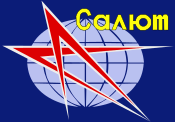Soyuz 12
| Mission type | Test flight |
|---|---|
| Operator | Soviet space program |
| COSPAR ID | 1973-067A |
| SATCAT no. | 06836 |
| Mission duration | 1 day 23 hours 15 minutes 32 seconds |
| Orbits completed | 31 |
| Spacecraft properties | |
| Spacecraft | Soyuz 7K-T No.1 |
| Spacecraft type | Soyuz 7K-T |
| Manufacturer | Experimental Design Bureau (OKB-1) |
| Launch mass | 6570 kg [1] |
| Landing mass | 1200 kg |
| Crew | |
| Crew size | 2 |
| Members | Oleg Grigoryevich Makarov |
| Callsign | Урал (Ural - "Ural") |
| Start of mission | |
| Launch date | 27 September 1973, 12:18:16 Site 1/5[2] |
| End of mission | |
| Landing date | 29 September 1973, 11:33:48 UTC |
| Landing site | 400 km at the southwest of Karaganda, Kazakhstan |
| Orbital parameters | |
| Reference system | Geocentric orbit[3] |
| Regime | Low Earth orbit |
| Perigee altitude | 194.0 km |
| Apogee altitude | 249.0 km |
| Inclination | 51.6° |
| Period | 88.6 minutes |
 Salyut program insignia | |
Soyuz 12 (Russian: Союз 12, Union 12) was a September, 1973, crewed test flight by the Soviet Union of the newly redesigned Soyuz 7K-T spacecraft that was intended to provide greater crew safety in the wake of the Soyuz 11 tragedy. The flight marked the return of the Soviets to crewed space operations after the 1971 accident. The crew capacity of the capsule had been decreased from three to two cosmonauts to allow for pressure suits to be worn during launch, re-entry and docking. It was the first time pressure suits were used for reentry since the Voskhod 2 flight.[4]
Crew
| Position | Cosmonaut | |
|---|---|---|
| Commander | Vasily Lazarev First spaceflight | |
| Flight Engineer | Oleg Grigoryevich Makarov First spaceflight | |
Backup crew
| Position | Cosmonaut | |
|---|---|---|
| Commander | Aleksei Gubarev | |
| Flight Engineer | Georgy Grechko | |
Reserve crew
| Position | Cosmonaut | |
|---|---|---|
| Commander | Pyotr Klimuk | |
| Flight Engineer | Vitaly Sevastyanov | |
Mission parameters
- Mass: 6,570 kg (14,480 lb) [1]
- Perigee: 194.0 km (120.5 mi) [3]
- Apogee: 249.0 km (154.7 mi)
- Inclination: 51.6°
- Period: 88.6 minutes
Mission highlights
As the first crewed test of the new version of the Soyuz ferry craft, Soyuz 12 was to have flown to a
Cosmonauts Lazarev and Makarov wore pressure suits for launch and landing, and would have worn them for a station docking, all changes brought about by the Soyuz 11 tragedy. The bulk of the suits and their environmental control systems limited the crew size to two.[4]
After the successful 27 September 1973 launch, the craft was maneuvered to a 326 x 344 km orbit on the second day in space,
See also
References
- ^ a b "Display: Soyuz 12 1973-067A". NASA. 14 May 2020. Retrieved 18 October 2020.
 This article incorporates text from this source, which is in the public domain.
This article incorporates text from this source, which is in the public domain.
- ^ "Baikonur LC1". Encyclopedia Astronautica. Archived from the original on 15 April 2009. Retrieved 4 March 2009.
- ^ a b "Trajectory: Soyuz 12 1973-067A". NASA. 14 May 2020. Retrieved 18 October 2020.
 This article incorporates text from this source, which is in the public domain.
This article incorporates text from this source, which is in the public domain.
- ^ ISBN 0-87201-848-2.

